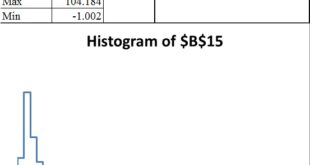I would like to say a bit on a matter of investment strategy and philosophy, sometimes repeating something that seems simple in isolation makes a world of a difference in how you perceive the big picture. There is a great guide to investing in stocks here that piggy backs off of many of these principals and better illustrates it using pics.
- The market has no guarantees, therefore to take advantage of opportunities of lower prices or “dips” within a greater uptrend, you should always have some cash, and if you prefer some “risk off” etf (such as currency etfs or bonds etfs, or even perhaps a more aggressive short hedge.)
- The market is not completely random, if it were and there were only the option of being long stock or cash, you would have 50% cash, 50% stock and rebalance and it would be the only way to make money and beat the market over a long period of time (if only very, very slightly.)
- Furthermore, money flows in and out of various assets. If it did so randomly you could hold an equal amount of all major asset classes, and simply maintain that same balance with the similar concept of there only being stocks and cash, but this way you would take advantage of more movement of capital. However, generally on a relative basis one asset is more attractive than another, and thus you should shift your weightings based upon expectations of capital flows and value so you have more allocated in the more favorable assets.
- Additionally, one asset may be more or less correlated in relationship to the others. The kelly criterion shows us that “independent bets” divided as small as possible and bet simultaneously produces the least volatility, and the most long term upside on risk. In reality, there are not really many independent bets, but “correlation” can be monitored, to avoid owning very correlated assets, and to produce an overall correlation to the market that increases with your degree of bullishness on the market (which should generally be greater on oversold conditions and uptrend signals). (see my post trend following strategy using sound money management principals)
- The market does not go straight up over time, however it does trend up over a very long period of time. If it were to go only up, you would be over 100% invested, if the gains exceed the cost of leverage. The market over a very long period of time goes up as production increases and money gets added to the money supply, therefore you must recognize that getting short is a very aggressive and generally short term move, unless it’s used as a way to reduce your overall exposure to “risk”. If you do use short as a strategy, it should generally be less aggressive than when you are long.
- Both buying the extreme oversold signals and reducing position on extreme overbought signals on multiple time frames, as well as following the trend have merit. Balancing these two factors should be a part of trend following.
- When too many people get bullish and lack funds to push it any higher, tops are made, when too many people sell and run out of funds to sell, or get too exposed to a short squeeze, they lack the selling pressure to push prices lower. Therefore, the principals of contrarianism on a longer term basis have some merit as well and are worth watching in combination with OB/OS signals on a monthly chart to anticipate the end of the trend.
- The market generally prices stocks by expected worth over a period of time compared relative to the other investments, with a few other factors considered. As a result, a 10% change in growth expectations over a year can drastically effect the price of the stock based on pricing it at 10 years of earnings over that time. A stock earning $1 per share with 0% growth might be worth $10 if you add up the $1 per share for 10 years. But with 10% growth, it becomes worth $15.93 assuming that growth is expected to consistently be maintained over a full 10 years. What’s more, in a year the 10 years worth of value will be 17.53 for the next 10 years if the growth is expected to continue. I explain this to illustrate both the pricing mechanisms in terms of expectations, and the dramatic effect they can have after big positive earning surprises and upward revisions, and to understand how big daily fluctuations in the market can still be somewhat rational. Additionally, both principals of understanding growth and value are important if you are choosing individual stocks, and if you are choosing ETFs, you need to still understand the value and the things that effect changes in growth in the macro economy. Growth is a very powerful factor, as such growth stocks offer greater potential as well as greater risk if expectations are wrong. The EMH (effiecient market hypothesis) is probably wrong to a degree, because everyone has different concepts of acceptable risks, and different ways to manage it, and different time frames, and everyone invests based upon expectations of earnings, which only need to change slightly to cause big differences in “fair value” measured by a stocks 10 years worth of earnings.the markets have proven to exist in mania phases. If for example, you expect demographics to cause a decline over a long period of time, but you are a short term trader, you probably won’t make any adjustments until it gets very close to the time frame in which the concern is there, and even then most investors who use earnings won’t project drastic changes based upon demographic trends
- Please note the drastic difference in behavior of value and growth stocks. Value stocks may swing among optimism and pessimism, but is not dependent upon growth. Generally more money going into a company (and higher prices) makes a value stock less attractive because it yields less. It is only when that money allows the company to invest the capital and through a high return on capital produces growth that a stock going up can be a good thing. However typically value stocks become more of a target as they grow and must posses barriers from competition growing such as a consumer monopoly and brand name recognition to simply prevent contraction.
- On the contrary, growth stocks for a large portion of their growth phase can become attractive if they are going up, (provided they don’t have excessive buying pressure in a short amount of time that is difficult to continue and are severely overbought). Many well managed growing companies use the additional capital they collect from investors to put to work in a productive way and further boost their growth and earnings. As a result, individual growth stocks in the right conditions can continue to go up for a long time until they reach a saturation point where additional capital becomes increasingly difficult to put to work to achieve the same kind of growth, which results in a decline causing some people to pull money out which contributes.
- Additionally, since expectations of growth is relatively arbitrary, a more rosy expectations can see prices drastically higher, while less rosy expectations can put a stock drastically lower. As a result, opportunities present themselves to buy the dips and sell the rips.
- A shift overall between growth and value can take place based upon the liquidity cycle and outlook and macroeconomic factors. If you expect growth to be inhibited, value stocks should be of larger weighting in your portfolio. If you expect growth to be strong, growth stocks may be best, provided the added risk of more growth can work within the context of your portfolio.
Taking into account all these factors and taking advantage of all these opportunities requires a delicate balancing of information and determining where to shift your assets. You have to be careful to generally go against the crowd at the extremes, but to follow the trends and lead the majority of the crowd in the trend. To buy an uptrend early enough, and hold onto it long enough to take advantage of the upward movement, but to still start selling into it early enough to profit and reduce position before the crowd does, and more aggressively start reducing your allocation when overbought. Meanwhile, identifying which assets specifically to bet on. Identifying the mispriced assets that offer high return with low risk. Perhaps you may also bet against those with high risk and low or more ideally, a negative return.
If you enjoy the content at iBankCoin, please follow us on Twitter




